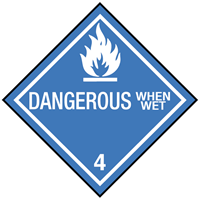
 Print
Print
Chemical Datasheet
SODIUM HYDRIDE |

|
Chemical Identifiers
| CAS Number |
UN/NA Number |
DOT Hazard Label |
USCG CHRIS Code |
|
|
|
|
|
| NIOSH Pocket Guide |
International Chem Safety Card |
|
none
|
none
|
NFPA 704
General Description
A silvery to whitish powder or slurry in oil. Used to make other chemicals.
Hazards
Reactivity Alerts
- Highly Flammable
- Strong Reducing Agent
- Water-Reactive
Air & Water Reactions
Highly flammable. Ignites or explodes in contact with air of high humidity [Bretherick 1979 p. 107]. Reacts violently with water producing a caustic solution (NaOH) and hydrogen (H2). Heat of reaction may ignite the hydrogen.
Fire Hazard
FLAMMABLE. MAY EXPLODE ON CONTACT WITH WATER. Accidental contact with water used to extinguish surrounding fire will result in the release of hydrogen gas and possible explosion. (USCG, 1999)
Health Hazard
SOLID: Will burn skin and eyes. Harmful if swallowed. (USCG, 1999)
Reactivity Profile
SODIUM HYDRIDE is a powerful reducing agent. Attacks SiO2 in glass. Ignites on contact with gaseous F2, Cl2, Br2, and I2 (the last at temperatures exceeding 100°C), especially in the presence of moisture, to form HF, HCl, HBr, and HI [Mellor 2:483 1946-47]. Reacts with sulfur to give Na2S and H2S [Bretherick 1979 p. 107]. Can react explosively with dimethyl sulfoxide [Chem. Eng. News 44(24):7 1966]. Reacts vigorously with acetylene, even at -60°C [Mellor 2:483 1946-47]. Spontaneously flammable in fluorine. Reaction with dimethylformamide, when heated, runs away [Chem. Eng. News, 1982, 60(28), 5]. Initiates a polymerization reaction in ethyl-2,2,3-trifluoropropionate such that the ester decomposed violently [Bretherick 5th ed. 1995]. Presence in the reaction of diethyl succinate and ethyl trifluoroacetate, has twice caused explosions [Chem. Brit., 1983, 19, 645].
Belongs to the Following Reactive Group(s)
- Metal Hydrides, Metal Alkyls, Metal Aryls, and Silanes
Potentially Incompatible Absorbents
No information available.
Response Recommendations
Isolation and Evacuation
Excerpt from ERG Guide 138 [Substances - Water-Reactive (Emitting Flammable Gases)]:
IMMEDIATE PRECAUTIONARY MEASURE: Isolate spill or leak area in all directions for at least 50 meters (150 feet) for liquids and at least 25 meters (75 feet) for solids.
LARGE SPILL: Consider initial downwind evacuation for at least 300 meters (1000 feet).
FIRE: If tank, rail tank car or highway tank is involved in a fire, ISOLATE for 800 meters (1/2 mile) in all directions; also, consider initial evacuation for 800 meters (1/2 mile) in all directions. (ERG, 2024)
Firefighting
Excerpt from ERG Guide 138 [Substances - Water-Reactive (Emitting Flammable Gases)]:
DO NOT USE WATER OR FOAM.
SMALL FIRE: Dry chemical, soda ash, lime or sand.
LARGE FIRE: DRY sand, dry chemical, soda ash or lime or withdraw from area and let fire burn. If it can be done safely, move undamaged containers away from the area around the fire.
FIRE INVOLVING METALS OR POWDERS (ALUMINUM, LITHIUM, MAGNESIUM, ETC.): Use dry chemical, DRY sand, sodium chloride powder, graphite powder or class D extinguishers; in addition, for Lithium you may use Lith-X® powder or copper powder. Also, see ERG Guide 170.
FIRE INVOLVING TANKS, RAIL TANK CARS OR HIGHWAY TANKS: Fight fire from maximum distance or use unmanned master stream devices or monitor nozzles. Do not get water inside containers. Cool containers with flooding quantities of water until well after fire is out. Withdraw immediately in case of rising sound from venting safety devices or discoloration of tank. ALWAYS stay away from tanks in direct contact with flames. (ERG, 2024)
Non-Fire Response
Excerpt from ERG Guide 138 [Substances - Water-Reactive (Emitting Flammable Gases)]:
ELIMINATE all ignition sources (no smoking, flares, sparks or flames) from immediate area. Do not touch or walk through spilled material. Stop leak if you can do it without risk. Use water spray to reduce vapors or divert vapor cloud drift. Avoid allowing water runoff to contact spilled material. DO NOT GET WATER on spilled substance or inside containers.
SMALL SPILL: Cover with DRY earth, DRY sand or other non-combustible material followed with plastic sheet to minimize spreading or contact with rain. Dike for later disposal; do not apply water unless directed to do so.
POWDER SPILL: Cover powder spill with plastic sheet or tarp to minimize spreading and keep powder dry. DO NOT CLEAN-UP OR DISPOSE OF, EXCEPT UNDER SUPERVISION OF A SPECIALIST. (ERG, 2024)
Protective Clothing
Wear rubber overclothing (including gloves). (USCG, 1999)
DuPont Tychem® Suit Fabrics
No information available.
First Aid
INGESTION: do NOT induce vomiting; neutralize alkali in stomach by drinking dilute vinegar, lemon juice, or orange juice; call a physician.
SKIN CONTACT: brush off all particles at once and flood the affected area with water. (USCG, 1999)
Physical Properties
Flash Point:
Not Applicable. Oil is flammable.
(USCG, 1999)
Lower Explosive Limit (LEL): data unavailable
Upper Explosive Limit (UEL): data unavailable
Autoignition Temperature: data unavailable
Melting Point: data unavailable
Vapor Pressure: data unavailable
Vapor Density (Relative to Air): data unavailable
Specific Gravity: data unavailable
Boiling Point:
Very high.
(USCG, 1999)
Molecular Weight: data unavailable
Water Solubility: data unavailable
Ionization Energy/Potential: data unavailable
IDLH: data unavailable
AEGLs (Acute Exposure Guideline Levels)
No AEGL information available.
ERPGs (Emergency Response Planning Guidelines)
No ERPG information available.
PACs (Protective Action Criteria)
| Chemical |
PAC-1 |
PAC-2 |
PAC-3 |
| Sodium hydride (7646-69-7)
|
1.2 mg/m3 |
13 mg/m3 |
79 mg/m3 |
(DOE, 2024)
Regulatory Information
EPA Consolidated List of Lists
No regulatory information available.
CISA Chemical Facility Anti-Terrorism Standards (CFATS)
No regulatory information available.
OSHA Process Safety Management (PSM) Standard List
No regulatory information available.
Alternate Chemical Names
- SODIUM HYDRIDE
- SODIUM MONOHYDRIDE


 Print
Print
